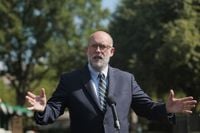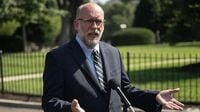On October 15, 2025, a courtroom in San Francisco became the unlikely stage for a high-stakes clash over jobs, politics, and the limits of presidential power. U.S. District Judge Susan Illston, responding to a plea from major federal employee unions, issued a temporary restraining order that blocked President Donald Trump’s administration from proceeding with sweeping layoffs of federal workers tied to the ongoing government shutdown. The move spared at least 1,200 healthcare agency workers from immediate termination, but its impact rippled far beyond a single agency or city.
The drama unfolded against the backdrop of a government shutdown that, by mid-October, had entered its third week—making it the third longest in U.S. history, according to reporting from the Los Angeles Times and Bloomberg. With ten failed Senate attempts to pass a funding resolution, the deadlock in Washington showed no signs of breaking. At the heart of the impasse was a fierce dispute over healthcare: Democrats demanded extensions of Affordable Care Act subsidies and reversal of recent Medicaid cuts, while Republicans, led by House Speaker Mike Johnson, refused to negotiate until Democrats set aside their demands.
But it was the Trump administration’s response to the shutdown that truly ignited legal and political fireworks. On October 10, President Trump announced a plan to cut approximately 4,200 federal jobs, with the promise that more layoffs would follow. In a post on Truth Social, Trump made no secret of his intentions: “I have a meeting today with Russ Vought, he of Project 2025 fame, to determine which of the many Democrat agencies—most of which are a political scam—he recommends to be cut, and whether or not those cuts will be temporary or permanent. I can’t believe the radical left Democrats gave me this unprecedented opportunity. They are not stupid people, so maybe this is their way of wanting to, quietly and quickly, Make America Great Again!”
That rhetoric was echoed by Russell Vought, Director of the Office of Management and Budget, who told "The Charlie Kirk Show" that the number of layoffs could "probably end up being north of 10,000," adding that the shutdown provided an opportunity to be “very aggressive where we can be in shuttering the bureaucracy, not just the funding.” According to Los Angeles Times, Vought’s comments revealed a strategy that went beyond mere budgetary belt-tightening and veered into the realm of political retribution.
Union leaders and their attorneys were quick to respond. The American Federation of Government Employees and the American Federation of State, County and Municipal Employees filed suit, arguing that the layoffs were not only arbitrary but also an abuse of power designed to punish workers and pressure Congress. Danielle Leonard, an attorney for the unions, told the court that the harm was immediate and multifaceted: “There are multiple types of harm that are caused exactly right now—emotional trauma. That’s not my word, your honor, that is the word of OMB Director Vought. Let’s cause ‘trauma’ to the federal workforce. And that’s exactly what they are doing. Trauma. The emotional distress of being told you are being fired after an already exceptionally difficult year for federal employees.”
Judge Illston, an appointee of President Clinton, was unsparing in her critique of the administration’s actions. She noted the lack of clear information about which cuts were actually occurring, the administration’s shifting estimates of job losses, and its failure to articulate a legal justification for the layoffs. “The evidence suggests that the Office of Management and Budget, OMB, and the Office of Personnel Management, OPM, have taken advantage of the lapse in government spending and government functioning to assume that all bets are off, that the laws don’t apply to them anymore,” Illston said, as reported by the Los Angeles Times. She dismissed the government’s explanation that the situation was “fluid,” remarking, “What it is is a situation where things are being done before they are being thought through. It’s very much ready, fire, aim on most of these programs. And it has a human cost, which is really why we’re here today. It’s a human cost that cannot be tolerated.”
The administration’s legal team, led by attorney Elizabeth Hedges, argued that the alleged harm to federal employees was not “irreparable” and could be addressed through other legal avenues. Hedges also claimed that federal employment disputes should be handled administratively rather than in district court, and pointed out that the reduction-in-force orders included 60-day notice periods, meaning layoffs were not immediate. But Judge Illston was unmoved, pressing Hedges on whether the administration believed its actions were legal. Hedges replied, “I am not prepared to discuss that today, your honor.” Illston retorted, “Well—but it’s happening. This hatchet is falling on the heads of employees all across the nation, and you’re not even prepared to address whether that’s legal, even though that’s what this motion challenges?”
After the hearing, the judge’s order barred the Trump administration from “taking any action to issue any reduction in force notices to federal employees in any program, project or activity” involving union members “during or because of the federal shutdown.” She also required the administration to provide a full accounting within two days of all reduction-in-force orders that would be blocked by her order, as well as the number of jobs affected. The administration, for its part, responded swiftly. On October 17, officials from the Treasury, Health and Human Services, and Homeland Security departments filed sworn declarations stating that their layoffs—affecting more than 2,000 employees—did not involve union members covered by the judge’s order. The legal wrangling was far from over.
Political stakes and human costs ran high. At a White House news conference, Trump doubled down, saying his administration was paying federal employees whom “we want paid” while using the shutdown to dismiss employees perceived as supporting Democratic initiatives. “Russell Vought is really terminating tremendous numbers of Democrat projects—not only jobs,” Trump said. Skye Perryman, president and CEO of Democracy Forward and co-counsel for the unions, praised Illston’s decision: “The statements today by the court make clear that the President’s targeting of federal workers—a move straight out of Project 2025’s playbook—is unlawful. Our civil servants do the work of the people, and playing games with their livelihoods is cruel and unlawful and a threat to everyone in our nation.”
Meanwhile, the shutdown’s effects continued to spread. The Trump administration kept military paychecks flowing and ramped up immigration enforcement, but slashed jobs in health, education, and even special education and after-school programs. Democrats stood firm on their demands for healthcare funding, while Republicans insisted no deal would move forward until those demands were dropped. As the standoff dragged on, uncertainty and anxiety gripped federal workers and their families across the nation.
Judge Illston scheduled a fuller hearing later in the month to consider a more lasting injunction. “It would be wonderful to know what the government’s position is on the merits of this case—and my breath is bated until we find that,” she remarked, underlining the unresolved nature of the legal and political battle. For now, at least, thousands of federal workers could breathe a little easier, their jobs temporarily secured by a judge’s gavel in San Francisco.

